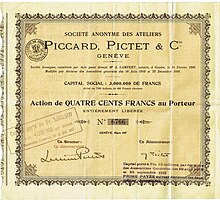Lucien Pictet

Lucien Pictet (born April 23, 1864 in Geneva , † December 3, 1928 in Paris ) was a Swiss engineer and manufacturer. From 1895 to 1920 he made a contribution to the development of the Geneva machine industry and was also politically active.
career path
Pictet completed an engineering degree at the Polytechnic in Zurich . He specialized in the construction of water turbines . After his internship at Escher, Wyss & Cie. he worked at the Ateliers de constructions mécaniques de Vevey (ACMV). In 1893 Pictet joined the Geneva company Faesch & Piccard . This was known for the “Faesch-Piccard-Turbine”, which was used in Geneva companies to drive machines. The large Edward Dean Adams Power Plant at Niagara Falls in North America went into operation in 1895 with turbines and regulators from the Geneva-based company.
After Jules Faesch's death in March 1895, Pictet became a partner in the company that was now called Piccard & Pictet . Paul Piccard (1844–1929) and Pictet converted the company into the limited partnership Piccard, Pictet & Cie. and in 1906 in the Aktiengesellschaft Soc. On. of the Atelier Piccard, Pictet & Cie. around. In 1898 the company moved to a larger factory in Charmilles .
Lucien Pictet founded the Société des Automobiles à Genève (SAG) in 1904 , which began producing automobiles in 1906. In the same year Piccard, Pictet also took up automobile production for SAG. The designer was Marc Birkigt , who also designed the vehicles for the Spanish company Hispano-Suiza . After the bankruptcy of SAG, Piccard, Pictet had been producing cars under the brand name "Pic-Pic" since 1910. During World War I , the company made good profits producing ammunition for the victorious powers. The company's share capital was increased from four million francs in May 1917 to ten million in September 1919 and the factory buildings were expanded considerably. Pictet was Chairman of the Board of Directors from 1909 to 1911 and from 1917 to 1920 . In 1920 the company employed around 1,800 people .
The new start with the production of the «Pic-Pic» automobiles failed because the designers could not get the manufacturing problems with the slide motors under control. In December 1920 Piccard, Pictet & Cie. Register for bankruptcy. As a rescue company , the banks founded the Ateliers des Charmilles SA in 1921 . The automobile production of the brand «Pic-Pic» continued with the support of Gnome et Rhône until 1924. - After 1981 the turbine construction went to the Ateliers de constructions mécaniques de Vevey (ACMV). The Georg Fischer AG (GF) took over the area in 1983 EDM machines as Charmilles Technologies and built this 2014 GF Machining Solutions made.
Pictet was from 1901 to 1904 the Democratic Grand Councilor of Geneva and from 1900 to 1914 he was a member of the Le Petit-Saconnex municipal council . - In the 1920s, he opened an optical instrument factory in France .
Lucien Pictet died in Paris on December 3, 1928.
family
Pictet's parents were the Geneva banker Ernest Pictet (1829-1909) and Gabrielle Elisabeth née Fuzier-Cayla. In 1891 he married Marguerite, daughter of Eugène-Etienne Rigot, mayor of Le Petit-Saconnex, and in 1914 Marguerite, daughter of Jean Chouet. From this come the children Jean Pictet (1914-2002), Vice-President of the International Committee of the Red Cross - he designed the Geneva Conventions of 1949 and Violette (1920-1996), who became known as an actress and writer under the pseudonym Isabelle Villars .
Pictet's brothers were the chemist Amé Pictet (1857-1937), the State Councilor and banker Guillaume (1860-1926), the editor Paul (1862-1947) and the zoologist Arnold Pictet (1869-1948). The National and Council of States Gustave Pictet (1827–1900) was her father's brother.
literature
- Bénédict Frommel: Lucien Pictet. In: Historical Lexicon of Switzerland .
- Jean de Senarclens: Piccard-Pictet & Cie .. In: Historisches Lexikon der Schweiz .
- Barbara Roth: Pictet. In: Historical Lexicon of Switzerland .
Web links
Individual evidence
- ^ DNB : Villars, Isabelle . (accessed on May 4, 2020)
| personal data | |
|---|---|
| SURNAME | Pictet, Lucien |
| BRIEF DESCRIPTION | Swiss engineer, manufacturer and politician |
| DATE OF BIRTH | April 23, 1864 |
| PLACE OF BIRTH | Geneva , Switzerland |
| DATE OF DEATH | December 3, 1928 |
| Place of death | Paris , France |



